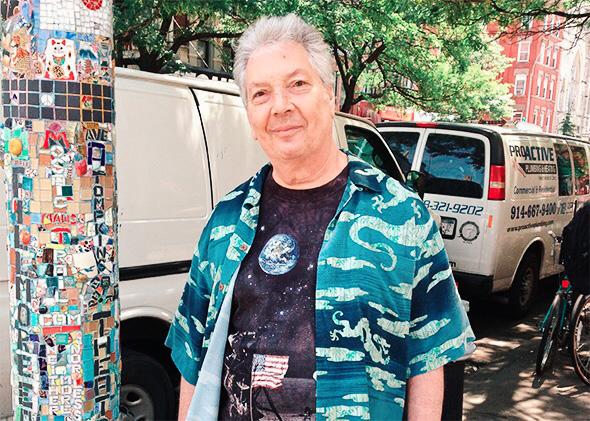In the dissenting opinion of this morning’s Supreme Court ruling on marriage equality, Justice Antonin Scalia memorably wrote: “Who ever thought that intimacy and spirituality (whatever that means) were freedoms? And if intimacy is, one would think Freedom of Intimacy is abridged rather than expanded by marriage. Ask the nearest hippie.”
So we did. Our nearest hippie was found on Saint Mark’s Place, a landmark of hippie history. He gave himself away via a T-shirt printed with an image of the 1969 moon landing underneath a Hawaiian shirt. Gerald Marks, who goes by Jerry, is a 74-year-old artist specializing in 3-D images and a longtime teacher. An edited and condensed transcript of our conversation follows.
Do you identify as a hippie?
The best art show I have ever seen in my entire life was produced by a commune called USCO, and they made their art communally, they lived communally, so they were hippies. One of the people I spoke with, a very intelligent woman who was one of their leaders, spoke about what “all her changes” were. Now if you know the expression “all my changes,” you may know it from the Neil Young song: “There is a place in North Ontario … all my changes were there.” The changes were the powerful spiritual changes that were the root of the hippie movement. It also meant having probably taken acid. Not routine drug abuse, but a profound spiritual quest. So I, inspired by that, became an artist and got some fame and did many things, and I had all my changes, so I guess in that sense I qualify as a hippie.
Justice Scalia said that marriage abridges freedom of intimacy. Do you believe that marriage abridges your freedom to be intimate?
I have never been married. I have had the same wonderful girlfriend for 26 years, and just being dedicated to her … it does limit. Like, if I walk down the street and I met a woman who was hot and was interested, I would turn her down.
You cannot imagine the change in the acceptance of homosexuality. I had friends in high school who were gay people—I mean, I know now with wisdom of looking back and the misery they suffered in their shortened lives; let’s remember that first of all, all of them are dead. Here I am, almost 75, and I’m this happy straight guy with a gorgeous girlfriend and we have wonderful times, and none of them are in that position.
I mean, the degree—you know this because you’ve heard about it and read about it, but it’s even more than you can imagine, the degree to which their lives were miserable.
Let me try to tie it up by comparing it to “all my changes,” to the hippie changes. My favorite movie quote is from Star Wars, and Luke is piloting his X-wing fighter toward the Death Star, and it’s very difficult, and he hears within himself the voice of his teacher, Obi Wan Kenobi, saying “Trust your feelings, Luke, let the force guide you.” And Luke turns off the autopilot and does his thing, and the important part is trust your feelings, being real with your feelings. That was what was essential to the hippie movement, it’s essential to the Trekkie movement and Star Wars, and it’s essential to the new changes in acceptance. Trust your feelings. Because all of these friends were not allowed to trust their feelings.
Spoken like a true hippie.
I really don’t think I qualify as a true hippie. Let me give you my card. I specialize in stereoscopic 3-D. I directed three music videos for the Rolling Stones.
Which ones?
“Paint It Black,” “It’s Only Rock and Roll,” and the ultimate hippie song, “2000 Light Years From Home.” You know that they did an album maybe 50 years ago called Their Satanic Majesties Request. That was the Stones’ psychedelic period. The Beatles were more psychedelic and had a longer psychedelic period, but Their Satanic Majesties Request was the Stones’ psychedelic album, and 25 years after that, the big song from that album, “2000 Light Years From Home,” they revived it on their Steel Wheels tour, and I made the videos for that song. It was a lot of special effects, and it reflected all my changes.
Did you ever drop acid?
Yeah, yeah. I didn’t repeatedly do it. I think the point I’m making is I wasn’t always on something, but after I was an artist for a year, a friend of mine obtained some legally produced—see it was legally produced at that time, it had just become illegal to have it, but I had what they called Pure Sandoz. Sandoz was the huge pharmaceutical corporation that invented it, so I had a long beautiful trip and I looked at my work and looked at my life and thought about the future, creativity, and vision. Saying I had an acid trip is like saying I was a visiting scholar at MIT—they both were big-time profound experiences. And so yes. It was important.
Read more of Slate’s coverage of same-sex marriage at the Supreme Court.
